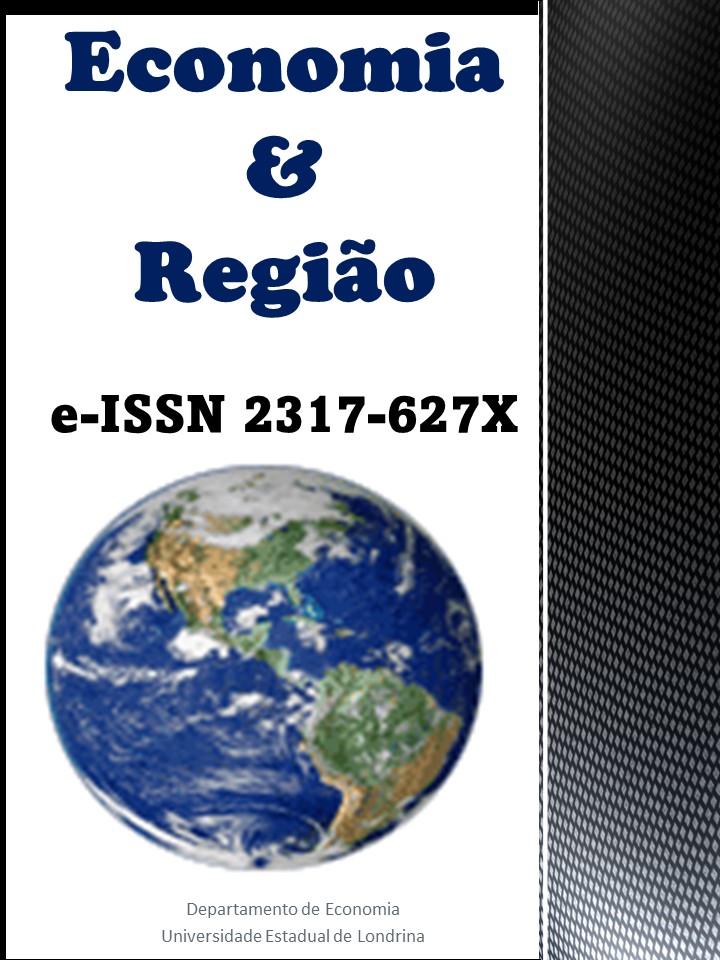Demand for meat in Brazil:
An analysis of the meat consumption of Brazilian families between 1970 and 2022
DOI:
https://doi.org/10.5433/2317-627X.2023.v11.n3.47297Keywords:
Consumo de carnes, demanda, elasticidadesAbstract
Meat consumption in Brazil underwent a major expansion in recent decades. Per capita consumption of meat went from 27kg to 97kg per in a 40-year period. Changes in the production along the last decades caused a decline in meat prices, increased production by farmers, and ultimately triggered an increase in meat consumption by the Brazilian population. The objective of this study is to estimate the household demand for meat in Brazil. We also sought to estimate the price elasticity of demand, cross-price elasticity of demand and income elasticity. The methodology is based on the Almost Ideal Demand System (LA-AIDS). Price data were obtained from the Agricultural Economics Institute (IEA, 2015) and the consumption data were obtained from the United States Department of Agriculture (USDA, 2015). The period of analysis is 46 years, from 1970 to 2015. The price and elasticities analysis show that beef, pork and chicken are normal goods and that there is strong substitutability relationship between beef and chicken, and between pork and chicken. Furthermore, there is a relatively low ratio of complementarity between beef and pork.
Downloads
References
BARBOSA, N. Evolução do PIB per capita e situação política. In: Fundação Getúlio Vargas – Instituto Brasileiro de Economia (FGV IBRE). Blog do IBRE. Rio de Janeiro, 6 de janeiro de 2020. Disponível em: https://blogdoibre.fgv.br/posts/evolucao-do-pib-capita-e-situacao-politica. Acesso em: abril de 2023.
BRANDT, S. A. Comercialização agrícola. Piracicaba: Livroceres, 1980.
CARVALHO, T. B. Estudo da elasticidade-renda da demanda de carne bovina, suína e de frango no Brasil. 2007. Dissertação (Mestrado em Economia Aplicada) – Universidade de São Paulo, Piracicaba, 2007. Disponível em: https://teses.usp.br/teses/disponiveis/11/11132/tde-05062007-130618/pt-br.php. Acesso em: março de 2023.
CHEN, D.; ABLER, D.; ZHOU, D.; YU, X.; THOMPSON, W. A meta-analysis of food demand elasticities for China. Applied Economic Perspectives and Policy, Athens, v. 38, n. 1, p. 50-72, 2016. DOI: https://doi.org/10.1093/aepp/ppv006 DOI: https://doi.org/10.1093/aepp/ppv006
COELHO, A. B. A demanda de alimentos no Brasil, 2002/2003. 2006. Tese (Doutorado em Economia Aplicada) – Universidade Federal de Viçosa, Viçosa, 2006. Disponível em: https://www.locus.ufv.br/handle/123456789/136. Acesso em: março de 2016.
COELHO, A. B.; AGUIAR, D. R. D.; EALES, J. S. Food demand in Brazil: an application of shonkwiler & yen two-step estimation method. Estudos Econômicos, São Paulo, v. 40, n. 1, p. 185-211, jan./mar. 2010. DOI: https://doi.org/10.1590/S0101-41612010000100007. DOI: https://doi.org/10.1590/S0101-41612010000100007
DEATON, A. S.; MUELLBAUER, J. An almost ideal demand system. American Economic Review, Pittsburgh, n. 70, p. 312-326, 1980. Disponível em: https://www.aeaweb.org/aer/top20/70.3.312-326.pdf. Acesso em: março de 2023.
ENGLE, R. F.; GRANGER, C. W. J. Cointegration and error correction: representation, estimation, and testing. Econometrica, New York, v. 55, n. 2, p. 251-176, 1978. DOI: https://doi.org/10.2307/1913236 DOI: https://doi.org/10.2307/1913236
FERNANDES, S. A.; PANIAGO, E.; LIMA, J. E. Análises de políticas relacionadas com a demanda e a oferta de carnes no Brasil. Revista de Economia e Sociologia Rural, Brasília, v. 27, n. 4, p. 556-561, 1989. Disponível em: https://www.revistasober.org/article/5da5a0e20e88257d60ba68e2/pdf/resr-27-4-437.pdf. Acesso em: março de 2016.
HOFFMANN, R. Estimativa das elasticidade-renda de várias categorias de despesa e de consumo, especialmente alimentos, no Brasil, com base na POF de 2008 – 2009. Revista de Economia Agrícola, São Paulo, v. 57, n. 2, p. 49-62, 2010. Disponível em: http://www.iea.sp.gov.br/ftpiea/publicacoes/rea/2010/rea2-4-2010.pdf. Acesso em: abril de 2016.
INSTITUTO BRASILEIRO DE GEOGRAFIA E ESTATÍSTICA -IBGE. População. Rio de Janeiro: IBGE, 2022. Disponível em: https://www.ibge.gov.br/estatisticas/sociais/populacao/9103-estimativas-de-populacao.html?edicao=17283. Acesso em: março de 2023.
INSTITUTO DE ECONOMIA AGRÍCOLA - IEA. Preços de varejo de carnes em São Paulo. São Paulo: IEA, 2022. Disponível em: http://www.iea.sp.gov.br/out/bancodedados.html. Acesso em: abril de 2023.
INSTITUTO DE PESQUISA ECONÔMICA APLICADA - IPEA. Consumo das famílias. Rio de Janeiro: IPEADATA, 2022. Disponível em: http://www.ipeadata.gov.br/. Acesso em: abril de 2023.
PARK, J. L.; HOLCOMB, R. B.; RAPER, K. C.; CAPPS JUNIOR, O. A demand system analysis of food commodities by U.S: household segmented by income. American Journal of Agricultural Economics, Milwaukee, v. 79, n. 3, p. 814-824, 1997. DOI: https://doi.org/10.2307/1243703 DOI: https://doi.org/10.2307/1243703
PINTOS-PAYERAS, J. A. Estimação do sistema quase ideal de demanda para uma cesta ampliada de produtos empregando dados da POF de 2002-2003. Economia Aplicada, Ribeirão Preto, v. 13, n. 2, p. 231-255, 2009. DOI: https://doi.org/10.1590/S1413-80502009000200003 DOI: https://doi.org/10.1590/S1413-80502009000200003
RESENDE FILHO, M. A. R.; BRESSAN, V. G. F.; BRAGA, M. J.; BRESSAN, A. A. Sistemas de equação de demanda por carnes no Brasil: especificação e estimação. Revista de Economia e Sociologia Rural, Piracicaba, v. 50, n. 1, 2012. Disponível em: https://www.scielo.br/j/resr/a/wD6TVRgbJQCRWH4HvDvrqSC/?format=pdf&lang=pt. Acesso em: março de 2016 DOI: https://doi.org/10.1590/S0103-20032012000100002
RESENDE FILHO, M. A. R.; SOUZA, K. J.; LIMA, L. C. F. Crises de segurança do alimento e a demanda por carnes no Brasil. Revista de Economia e Sociologia Rural, Piracicaba, v. 54, n. 3, 2016. DOI: https://doi.org/10.1590/1234-56781806-94790540304. DOI: https://doi.org/10.1590/1234-56781806-94790540304
ROPPA, L. Brasil: consumo de carnes passado a limpo!. Aveworld, [s. l.], p. 10-14, fev./mar. 2008.
SANTANA, A. C.; RIBEIRO, D. T. Sistema de demanda de carnes no Brasil: modelo de equação aparentemente não-relacionada. In: CONGRESSO DA SOCIEDADE BRASILEIRA DE ECONOMIA, ADMINISTRAÇÃO E SOCIOLOGIA RURAL - SOBER, 46., 2008, Acre. Anais [...]. Acre: SOBER, 2008. Disponível em: https://ideas.repec.org/p/ags/sbrfsr/109115.html. Acesso em: abril de 2023
SILVA, G. L. S. P.; TOYAMA, N. K.; YOSHII, R. J.Oferta e demanda de frango no Estado de São Paulo. Revista de Economia e Sociologia Rural, Piracicaba, v. 15, n. 1, p. 193-207, 1977. Disponível em: http://www.resr.periodikos.com.br/journal/resr/article/61bce147a953954fc3715b24. Acesso em: abril de 2023.
TRAVASSOS, G. F.; COELHO, A. B. Padrão de substituição entre carnes no consumo domiciliar do Brasil. Revista de Economia e Sociologia Rural, Piracicaba, v. 2, n. 55, p. 285-304, abr./jun. 2017. DOI: https://doi.org/10.1590/1234-56781806-94790550205. DOI: https://doi.org/10.1590/1234-56781806-94790550205
TSHIKALA, S. K.; FONSAH, E. G. Estimating the U.S. demand for melons: a dynamic analysis approach. Journal of International Food & Agribusiness Marketing, London, v. 24, n. 4, p. 306-320, 2012. DOI: https://doi.org/10.1080/08974438.2012.716332. DOI: https://doi.org/10.1080/08974438.2012.716332
ULUBASOGLU, M.; MALLICK, D.; WADUD, M.; HONE, P.; HASZLER, H. Food demanda elasticity for Australia. Australian Journal of Agricultural and Resource Economics, Adelaide, v. 60, n. 2, p. 177-195, 2016. DOI: https://doi.org/10.1111/1467-8489.12111. DOI: https://doi.org/10.1111/1467-8489.12111
UNITED STATES DEPARTMENT OF AGRICULTURE – USDA. Consumo de carne bovina, suína e frango. Washington, D.C.: USDA, 2022. Disponível em: http://apps.fas.usda.gov/psdonline/ Acesso em: abril de 2023
WONG, L.; SELVANATHAN, E. A.; SELVANATHAN, S. Modelling the meat consumption patterns in Australia. Economic Modelling, Brisbane, v. 49, p. 1-10, 2015. DOI: https://doi.org/10.1016/j.econmod.2015.03.002 . Acesso em: abril de 2023 DOI: https://doi.org/10.1016/j.econmod.2015.03.002
Downloads
Published
How to Cite
Issue
Section
License
Copyright (c) 2023 Augusto Alves Neto, Geraldo Costa Junior

This work is licensed under a Creative Commons Attribution 4.0 International License.
Economia & Região adota a Licença Creative Commons Attribution CC-BY 4.0 International, portanto, os direitos autorais relativos aos artigos publicados são do(s) autor(es), que cedem à Revista Economia & Região o direito de exclusividade de primeira publicação.
Sob essa licença é possível: Compartilhar - copiar e redistribuir o material em qualquer suporte ou formato. Adaptar - remixar, transformar, e criar a partir do material, atribuindo o devido crédito e prover um link para a licença e indicar se mudanças foram feitas.














